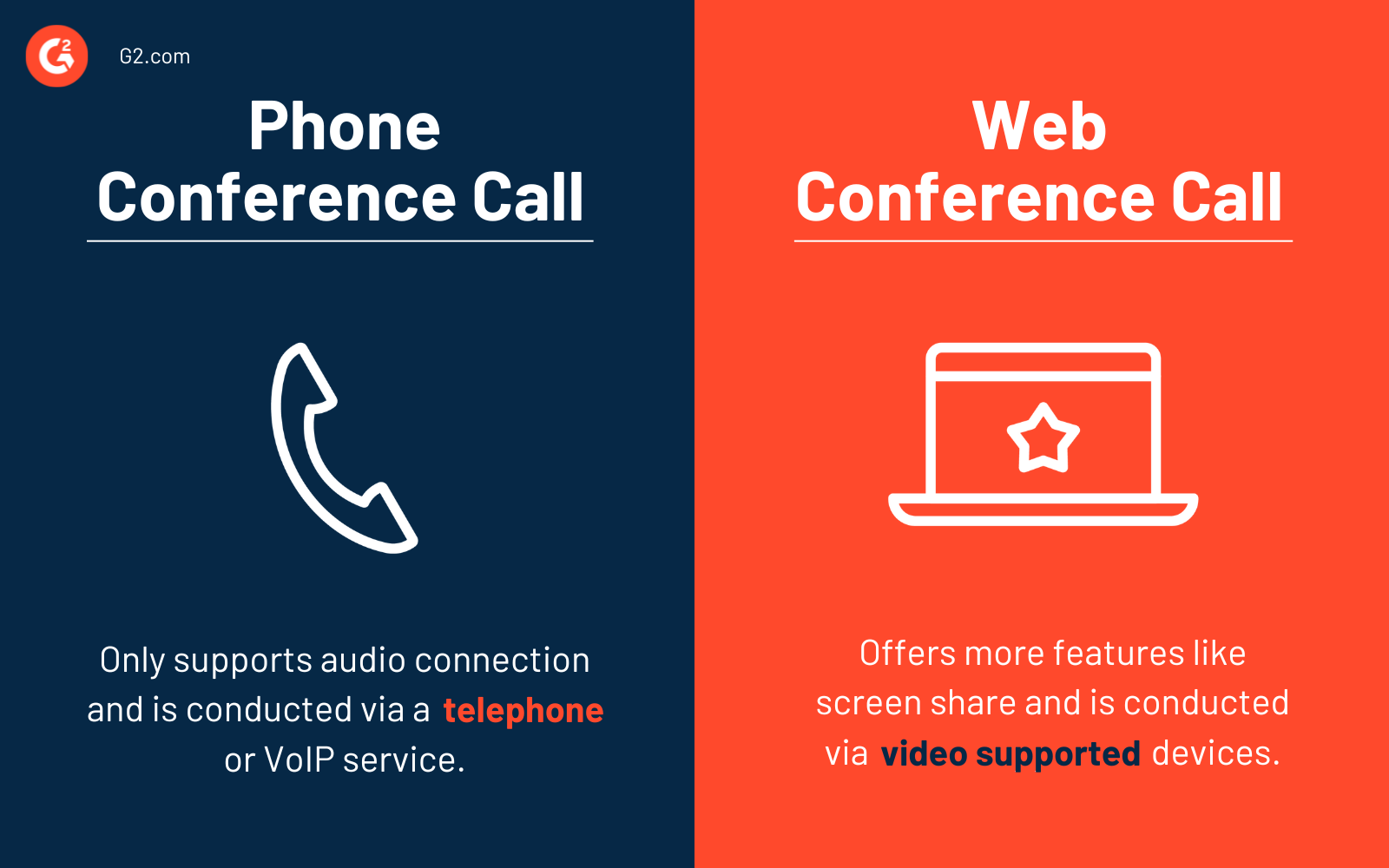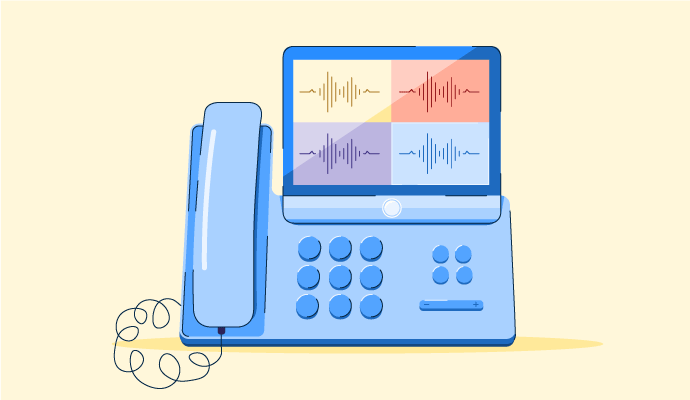The traditional ways of conducting business are evolving.
Many things define the “new normal”, including remote work. The pandemic started by making working from home a necessity; now, it’s a widely permissible choice. And nothing conveys this experience more accurately than the regular sync-ups over conference calls.
What is a conference call?
A conference call is a telephone call used for internal and external communications, like with employees, customers, and business partners. It requires an audio, video, or web connection that involves multiple participants. The participants dial a shared number on their phones to connect to the same virtual meeting room.
Many companies use audio conferencing software to set up, host, and manage their professional communication needs. These tools are often compatible with web-based conferencing that enables videos, screen sharing, and other collaboration tools like live chat and content sharing.
Over the past decade, conference calls have gained immense popularity and importance as more companies expand their geographical presence. As the concept of working from anywhere continues to grow, this technology is a necessity for modern businesses.
Top free audio conference call software
- Workplace from Meta
- Spike
- LoopUp
- JustCall
- PowWowNow
- Voximplant
- Infinite Connect
- MobileDay
- Nynja
- Stackfield
* These are the top 10 free audio conference call software based on G2 data collected in July 2024.

How does a conference call work?
Invited callers join a conference call via landline by entering the shared number on their dial pads to connect to a conference bridge. The conference bridge is a virtual room allowing several people to host or join meetings simultaneously. You may own a conference bridge or subscribe to host conference calls on another company’s bridge.
Call participants can also use a mobile app to make a conference call on iPhones or Android devices. Alternatively, they can set up a voice-over-internet protocol (VoIP) phone system to join with a desktop system or mobile phone.
VoIP allows participants to join from computers instead of traditional telephones. While the conventional dial-in method is perfect for the times you don’t have an internet connection or can’t access a desktop device, VoIP calls are considerably cheaper than traditional calls.
However, in most cases, both types can connect to the same conference bridge, so participants can join using any method.
Three main components are needed for a conference call.
- The dial-in number is the phone number you receive from the service provider. The callers need it to join a conference call. It’s either a toll number that costs participants a fee or a toll-free number chargeable to the host.
- The access code comprises seven symbols and needs to be entered when joining a conference call. The host distributes this unique code to all participants.
- The personal identification number (PIN) is used by the host to start the conference call. It gives them access to functions like call recording, participant count, and conference lock.
If you're looking to take your conference calls to the next level, the right software can make all the difference. Check out my review of the 8 best video conferencing software to find the ideal platform that keeps your meetings productive and engaging.
Want to learn more about Audio Conferencing Software? Explore Audio Conferencing products.
How to make a conference call
If we’re talking about traditional conference calls made from desk phones, the setup is quite restricted. It allows for limited control over audio and participation. The callers need the dial-in number and access code handy to input on the call and connect to the same virtual room.
Making a conference call via distributed dial-in number
Here’s how to start a conference call using a dial-in number.
- Step 1: Send out a calendar invite well in advance of conducting the meeting. Make sure to add a note for the participants with the necessary details like the date, time, dial-in number, and access codes.
- Step 2: Input the dial-in number to connect to your virtual meeting room on the day of the meeting.
- Step 3: Enter the access code, followed by the PIN code (if prompted). For some providers, the access code is enough to start the call.
- Step 4: Once you’ve entered the necessary details, simply wait for others to join the room before starting the meeting.
Making a conference call via ad hoc conferencing
The steps that go into ad hoc conferencing solutions differ from the dial-in method.
- Step 1: The organizer needs to set up the conference bridge uniform resource locator (URL) to manage and connect multiple callers simultaneously.
- Step 2: The organizer then calls all the participants using VoIP software and adds them to the virtual room.
- Step 3: Once all the participants have joined the room, the call begins. Only the organizer can end the meeting, but participants are free to leave.
$32.4 billion
is the estimated value of the audio conferencing services market by the end of 2026.
Source: Market Data Forecast
Types of conference calls
To fulfill your business conferencing needs adequately, you have to understand the difference between the types of conference calls. There are three types to consider.
Audio conferencing
This type of conference call connects multiple callers via any VoIP-based phone service. Since they rely solely on telephone lines, audio conference calls are easy to set up. Audio conference calls come in different forms, such as:
- Reservationless conference calls are cost-effective and don’t require any prior booking. You only need a conference call service provider to facilitate this call on demand. Callers can dial in at any time.
- Operator-assisted conference calls are slightly more expensive than the reservation-less type. This type of conference call has an operator on the line to manage the call. The service also includes perks like call recording and transcription.
- Three-way calls are the simplest option, requiring no audio conferencing solutions or additional services. However, they’re slightly limited compared to other options. For instance, your audio control is confined to how loudly you speak or how well you hear audio, and the maximum number of participants might not be more than five people.
- Earnings conference calls are public calls between a company, its investors, and stakeholders. They’re conducted to explain a company’s financial performance and plan for the next financial quarter.
Video conferencing
To use video conferencing, participants engage in an audiovisual environment by connecting to the same online meeting room. A webcam enables video meetings, allowing callers to interact with each other over high-definition video conferencing in real time.
This is the closest alternative to in-person meetings because users see each other’s facial cues and body language. Even when using the best video conferencing software, a high-speed internet connection is necessary. With good connectivity, the participants can avoid technical difficulties like blurry images or lag.
Web conferencing
Web conferencing takes video calls to the next level. Not only can users interact with each other in real-time, but they can also share media and their screens to use other collaborative tools missing from audio and video conference calling platforms.
Even though web conferencing provides an immersive experience, it can be slightly expensive and requires some level of training and setup to use the many available tools.
Phone conference call vs. web conference call
To conduct any form of conference call, you need to sign up with your service provider and get your dial-in numbers along with access codes.

Phone conference calls were traditionally conducted through landline connections using a desk phone. If you don't have a stable internet connection, this is still a viable option. Otherwise, you can connect the internet to your desk phone and install a VoIP service.
Web conference calls offer more features than phone conference calls. It uses devices that support video connections like smartphones, laptops, and tablets and offers smart features like real-time messaging through chat, screen and media sharing, and webcam support.
Conference call use cases
Conference calls provide versatile ways for large groups of people to communicate across the world. They’re a great tool for connecting remote teams and global offices. Check out some specific use cases below.
1. Client phone calls
Your whole team can connect with clients as a group using conference calls. You can communicate with your customers in a virtual workplace and take advantage of integrated features like instant messaging, media sharing, and audio controls to provide a good experience.
2. Internal communications
If your team members are working from multiple locations, conference calling brings everyone together. It simplifies team communication for brainstorming and discussing critical details without the need to go back and forth with long emails.
3. All-hands meetings
All-hands meetings use conference calls to connect with teams in different locations. Conferencing is a great way to conduct Q&A sessions, as it can host large groups of callers while providing high audio quality for easy interaction.
Best practices for conference calls
From loud background noises to lagging facial cues, a lot can make a conference call awkward. Work on your conference call etiquette before your next big meeting.
1. Test equipment in advance
Nothing says “unprofessional” louder than disruptive connections, especially when addressing a larger group. Test your equipment before conference calls to avoid any last-minute faux pas.
2. Find a quiet corner
Similar to addressing technical difficulties, be sure your physical surroundings are well-equipped to join or host a conference call. If you can help it, don’t answer calls from busy streets or cabs while you’re on the run. Also, mute and unmute your mic at the correct times.
3. Use the right collaboration tools
If you’re connecting via web conferencing, pick the right collaboration tools to make your calls more immersive. For instance, screen-sharing software is great for presentations, or you can use a call recording tool for training purposes. Other options include call transcripts, custom hold music, collaborative whiteboard solutions, and instant chat.
4. Record your meeting
You can keep recordings as resources to share with the callers who weren’t present. Recordings also provide receipts for a record of decisions made during the call and a reference point for future meetings.
5. Invest in the right software
To get the best conference call experience, find the right audio conferencing software for your needs. Enlist a provider that allows you to host conversations on an audio conferencing bridge for several large groups in different locations.
Best audio conference call solutions in 2024
With audio conferencing software, you can host voice calls between several parties working from separate locations. It's ideal for small group calls but mainly facilitates professional meetings.
To be included in this category, a product must:
- Enable audio communication via a public switched telephone network (PSTN) or mobile network for easy collaboration
- Host multi-user audio calls on an audio conferencing bridge
*Below are the top 5 leading audio conferencing software from G2’s Summer 2024 Grid® Report. Some reviews may be edited for clarity.
1. Workplace from Meta
Workplace from Meta is an all-in-one business communication tool that keeps employees engaged and connected. It supports your favorite players like Google Calendar and Microsoft Outlook and even allows custom integrations.
New customers can sign up for a free 30-day trial of Workplace from Meta and use it for free! The company also offers its service for free to eligible non-profit charitable organizations.
What users like best:
“Workplace's primary benefit is team collaboration through chat and conferencing. Grouping, however, is the best component. Each group has its own information and knowledge base.”
- Workplace from Meta Review, Mohammed Shohrab H.
What users dislike:
“I think the platform is a little confusing for new users. It would help to have an initial greeting that lets you know what you can accomplish using the platform.”
- Workplace from Meta Review, Val C.
2. Spike
Convert your email into an office! Spike provides everything from messaging and collaboration to audio/video calls in one platform, allowing you to communicate better and faster.
Spike's free forever plan supports unlimited one-on-one audio and video conference calls, along with added features like collaborative notes and chat.
What users like best:
"I have used dozens of email platforms, but the way spike threads communicate makes it so easy to find and engage. It treats comms like text messages and threads based on the person, not the subject line, which is huge.”
- Spike Review, Peter J.
What users dislike:
"I would love to see more account options and controls for out-of-office. Also, being able to merge in other non-email channels into one comms thread would be great.”
- Spike Review, Peter J.
3. PowWowNow
PowWowNow offers a user-friendly and cost-effective audio conferencing solution tailored for businesses seeking reliable and straightforward communication tools. Renowned for its no-nonsense approach, PowWowNow ensures seamless connectivity, making it an ideal choice for organizations of all sizes.
What users like best:
"PowWowNow is super easy to use. There are no hidden costs, and it allows me to initiate virtual calls spontaneously without prior reservation. It provides toll-free and local dial-in numbers, allowing people from around the globe to join the meeting."
- PowWowNow Review, Siddhant G.
What users dislike:
"Some possible issues that users may encounter include technical difficulties with the platform, poor internet connectivity causing poor video or audio quality, and difficulty in replicating the level of engagement and spontaneity that can be achieved in face-to-face meetings. Additionally, some users may prefer in-person meetings and find virtual meetings less satisfying."
- PowWowNow Review, Rithik D.
4. Unified Communications as a Service (UCaaS)
Unified Communications as a Service (UCaaS) is an advanced, cloud-based communication solution designed to meet the complex needs of modern enterprises. This service integrates various communication tools into a single, cohesive platform, enabling seamless collaboration and connectivity across your organization.
What users like best:
"Onboarding was easy and stress-free, the team is friendly and communicative. Switching from traditional phone service to Teams Phone was easier than expected."
- Unified Communications as a Service Review, Joe Y.
What users dislike:
"Calls coming through the call center sometimes will drop or not go through to agents in queue."
- Unified Communications as a Service Review, Mike S.
5. InterCall Reservationless-Plus Conferencing
InterCall Reservationless-Plus Conferencing facilitates seamless communication for businesses of all sizes. Whether you're hosting a team meeting, a client presentation, or a large-scale corporate event, this platform offers reliable, high-quality audio connections that keep your conversations clear and uninterrupted.
What users like best:
"I love that I don't have to reserve a bridge or worry that someone else in my office may need the line. I can have a call spontaneously and decide, at the moment, to record for later playback - a review. We deal with complex IT issues. Catching all the technical details in a call is CRITICAL. The fact that I can record my conference calls is incredibly valuable."
- InterCall Reservationless-Plus Conferencing Review, Kelli J.
What users dislike:
“Billing processes are so inconvenient, and the staff doesn't seem to have a handle on problem-solving."
- InterCall Reservationless-Plus Conferencing Review, Josh W.
Let’s circle back on that
Conference calls will only stay in high demand as we continue to do business with anyone from anywhere. Thankfully, costs are low, and providers offer great support. For organizations with a global workforce, excellent communication is key to survival.
If you’re looking for more ways to enhance company-wide communications, take a look at the best business instant messaging software to facilitate effective connections across departments and teams.

Washija Kazim
Washija Kazim is a Sr. Content Marketing Specialist at G2 focused on creating actionable SaaS content for IT management and infrastructure needs. With a professional degree in business administration, she specializes in subjects like business logic, impact analysis, data lifecycle management, and cryptocurrency. In her spare time, she can be found buried nose-deep in a book, lost in her favorite cinematic world, or planning her next trip to the mountains.
